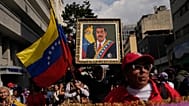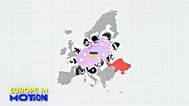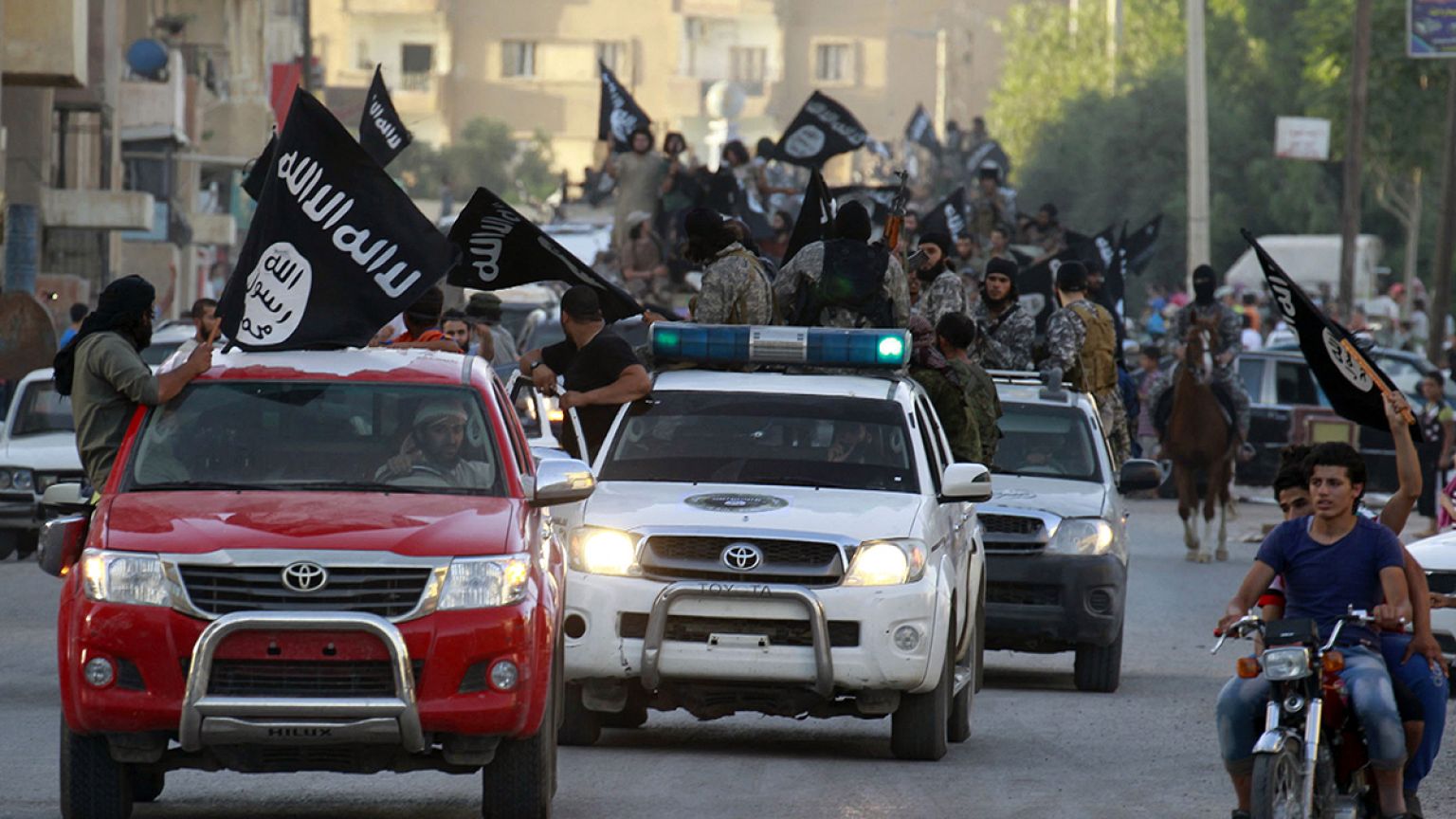In public meetings or online propaganda videos, Islamist hymns, known as anasheed jihadiya or simply nasheeds, have become inseparable from the image of violent groups in the Middle East. These chants are now the soundtrack of jihad.
Nasheeds were not always so significant in the jihadi culture, their rise has been only recent. “There was an increase of songs after the outbreak of the Arab Spring and the diversification of the jihadi scene which was no longer represented by al-Qaeda alone”, Behnam T. Said, a PhD candidate at the University of Jena whose research focuses on jihadi nasheeds, tells euronews in an e-mail interview.“But an even stronger increase of new nasheeds could be observed during the last years within the context of the war in Syria and Iraq.”
Nasheeds exist in: - Arabic
- Pashtu
- Urdu
- Turkish
- Bosnian
- English
- German
- Dutch
The style of nasheeds, while it follows strict rules, relies almost always on an imposing chorus of voices. Producers use computer programmes to multi-track the audio and sometimes autotune, and make it seem “more impressive,” NBCNews reports, as though many more people are singing in perfect harmony. “Most recent nasheeds production values would stand alongside any commercially produced record.” The singers are almost always male, their voices sometimes interrupted by martial goose stepping, firearms or cavalcade sound effects.
ISIL's "quasi-official anthem" is a nasheed
“There are nasheeds used by different Islamic groups who are engaged in battle, Sunni or Shia. But many new songs are produced by one of the most powerful actor on the battlefield: the Islamic State (also known as the Islamic State in Iraq and the Levant or ISIL) and its supporters,” Said tells euronews.
Said published a research article in 2012 which presents the most important findings of his current PhD project, one of the most comprehensive and recent studies of these Islamist hymns.
“The most famous song from [ISIL] is called “My ummah, Dawn has appeared, so await the expected victory,” he adds.
The song was released at the end of 2013 by Ajnad Media Foundation, according to Aymenn Jawad Al-Tamimi, a Shillman-Ginsburg fellow at the Middle East Forum. For Al-Tamimi, the Foundation is actually an ISIL-founded “media unit specialized in jihadi audio chants.” Its very existence suggests nasheeds are crucial to the militant group.
"My Ummah, Dawn has appeared”
(Edit : this video has been changed from the original version, taken down from Youtube)
For Said, this nasheed “is a mighty song with a powerful and hopeful message which comes from a position of strength not of weakness,” a stark difference, he says, “from older songs which often underline the status as a small opposition confronting a mighty state and its security forces.”
Al-Tamimi goes as far as to say that this nasheed “has become a quasi-official anthem for ISIL.”
According to Al-Tamimi’s translation of the song, it includes verses such as:
"The Islamic State has arisen by the blood of the righteous,
The Islamic State has arisen by the jihad of the pious,
They have offered their souls in righteousness with constancy and conviction,
So that the religion may be established in which there is the law of the Lord of the Worlds."
This very nasheed can be heard in a VICE documentary on the Islamic State organisation, during a “Caliphate establishment celebration” in Raqqa, Syria. The song is played in the background of the ceremony used by the hardcore Sunni jihadists as a proselytising event and a recruitment drive. There, they also distribute food to break the fast. The scene is shot during Ramadan. Militants are shown to make the population of the city pledge allegiance to ISIL leader Abu Bakr al-Baghdadi.
Nasheeds are widely available online
Away from the battlefields of the Middle East, nasheeds are also widely available online. Of course, there was “already a distribution before the Internet via song books, cassettes and videos but the internet worked as a catalyst,” Said tells euronews. It is “more than just a distributor. Users in online forums are engaged in discussions about the permissibility of nasheeds, they are asking for specific songs they came across in videos etc.”
“In the most popular jihadi forums you find special sections for “sautiyat” (audios),” Said, who is currently working as an intelligence analyst based in Hamburg, writes (see reference), “where almost all kind of jihadi songs are available, sometimes even whole nasheeds collections with more than 400 tracks,” along with lyrics.
In a few clicks, euronews found similar forums, web portals and even a subreddit, that host hundreds of MP3s of nasheeds, available to stream or download.
On Youtube, a search for “nasheed” returns 1.3 millions results (and more than 80,400 for “jihad nasheed”), large parts of which use military imagery and claim geographical origins from Chechnya to Bosnia.
Militant Islamist groups have no qualms using Western inventions like the Internet to circulate their hymns: “Jihadists are very pragmatic,” Said tells euronews. “You will find that scepticism more amongst purist Salafis, like Nasir al-Din al-Albani and many Wahhabi scholars from Saudi Arabia.”
Types of nasheeds
According to Behnam Said, there are four categories of nasheeds: 1. Battle hymns: to encourage and mobilize the warriors and their supporters. 2. Martyr hymns: except for some notable exceptions, they not dedicated to a single person but to the idea of martyrdom itself. 3. Mourning hymns: a very old sort of poetry in the Arab (...) they are dedicated to a special person. 4. Praising hymns: Poems praising a high-standing person are a known type of Arab poetry and called madih (praise).The most common attributes are generosity, bravery, and honor. Palestine is also a recurring topic and could almost be considered a whole genre of nasheeds. Source
Peter Neumann, a professor of Security Studies at the Department of War Studies at King’s College, London, sees irony in the situation. “There has never been an objection to using Western technology, for example, as long as its use is for a religiously permitted purpose” Neumann explained during an interview on NPR.
“That’s always been the sort of irony and contradiction of this movement – that they are essentially trying to establish states that are following medieval rules, but they are taking advantage of the Internet” and other cutting-edge technologies, according to Neumann, who is the director of The International Centre for the Study of Radicalisation (ICSR).
No possible control online
Ubiquitous online, nasheed video music are at times banned from video-hosting platfroms, but “in most cases not because of the nasheeds but because of the footage,” Said, who wrote an upcoming book on ISIL, explains.
“But you can still access nasheed videos on internet platforms quite easily. The songs have spread so far and there are so many that it is not possible to control their spread via internet. Also, in many cases you need experts telling you whether the song is a radical one or not and why it should be banned or not. So this is a quite complex task.”
Indeed, if sometimes the pictures or footage which illustrate the videos leave no doubt of its support for violent jihadist groups, at times the symbols used, such as lions, or scimitars, are ambiguous.
Other propaganda videos do not contain violence but are posted by accounts claiming to be linked to ISIL.
The following video was posted by the account “ISIS Baghdad” on October 7, 2014. It shows militants slaughtering cows in front of an ISIL flag, then butchering and donating the meat to families aboard a pickup truck which carries the same flag.
Uploaded for the Eid al-Adha, the “festival of the sacrifice”, it aims at depicting ISIL as a benevolent, caring and pious organisation as it is a tradition throughout the Islamic world to donate part of the sacrificed beast to neighbours and to the poor and needy. The whole butchering and distribution scene is scored with a nasheed.
For video-hosting platform Youtube, it is a case of finding the right balance between freedom of expression and removing violent videos.
“YouTube has clear policies prohibiting content intended to incite violence, and we remove videos violating these policies when flagged by our users. We also terminate any account registered by a member of a designated Foreign Terrorist Organization and used in an official capacity to further its interests” a Youtube spokesperson told euronews. “We allow videos posted with a clear news or documentary purpose to remain on YouTube, applying warnings and age-restrictions as appropriate.”
A multi-lingual team of moderators in different parts of the world work 24/7 to evaluate flagged content and act if needed. According to the Guardian, YouTube, which is owned by Google, has also given a number of government agencies “trusted” flagger status to prioritise their reporting of dangerous or illegal material.
Nasheeds predate ISIL by decades
Nasheeds actually predate Youtube, the Internet or ISIL by decades. The jihadist poetry comprised in the Islamist hymns can be, according to Said’s research, seen as an extension of an nineteenth century anti-colonial poetry style called qaseeda.
However, the historical roots can be found in a more recent period: “many nasheeds used today in videos by terrorist organizations can be traced back to the early 1980s and late 1970s, the decades that are known as the era of “Islamic resurrection”,” the PhD candidate explains.
During this period, Islamists in Syria and Egypt locked horns with their respective authoritarian governments. The struggles included a culture war where nasheed songbooks, records and cassettes were weapons to change the public’s interpretation of Islam. At the same time, in Saudi Arabia, exiled Egyptian Muslim Brotherhood members set up youth camps where attendees sung nasheeds. A young Saudi named Osama bin Laden also established a nasheed group in the 1970s, Said points out.
The 1980’s, with the Soviet invastion of Afghanistan and the 1987 Intifada as a backdrop, saw the rise of a more politicised style of nasheeds, calling for “Islamic resistance against the occupation”. The hymns are mentioned in the Hamas charter, where they are said to be, along other cultural goods, “necessary for ideological education and invigorating nourishment to continue the struggle and relaxing the spirit.”
Further east, with scores of foreign fighters going to fight the Soviets in Afghanistan, “the record ‘Caravan of the martyrs’ was one of the first jihadist nasheed albums that became famous” Said writes. The record’s first edition – several followed – included songs about Arabs who lost their lives in Afghanistan between 1987 and 1990.
Rules for nasheeds
According to Salafi scholar Nasir ad-Din al-Albani, Islamic nasheeds are only allowed if :
- the melody is not similar to the teachings of western or eastern music, which make people dance.
- the text is purely Islamic.
- there are no musical instruments used, except for the duff (which is allowed only for women at weddings).
- the listening to nasheeds does not distract from the study of the Quran.
This dual heritage is, for Said, a sign that “the roots of jihadi culture possibly lies in the Muslim Brotherhood tradition rather than in Wahhabism or that it merged the two influences to a unique culture.”
If Wahhabis and Salafis share a similar view, which is more or less suspicious of nasheeds but not haram if the hymns follow a set of rules (see box), the Muslim Brotherhood has a more relaxed stance on music. So these two influences can explain the extensive use of nonetheless codified nasheeds by jihadist groups.
A potential for radicalisation?
As a result of the spread of nasheeds online, jihadists are not the only ones who can access them. Jihad sympathizers too “can get in touch with this material easily because you will find many hardcore nasheeds not exclusively on jihadist websites but also on sites that claim to provide ‘Islamic nasheeds’,” Said writes.
The extended reach for easily accessible nasheeds may play a role in the “new forms of militant activism described as ‘virtual self-recruitment’” by the ICSR in a 2008 report. In response, the Centre called then for more attention to be paid to extremist activities online.
Said is not so convinced about the radicalising potential of nasheeds: “someone who just listens to nasheeds without having a radical mindset, like me as a researcher, won’t be effected”.
According to him, despite the intention of the jihadi groups, songs can’t radicalise someone on their own. Only “in combination with other factors” could they have this effect on a rational and emotional level.
“We clearly see that the [producers’] intention is to radicalise people and to make them give their life in battle. But we don´t have strong evidence about the effects of nasheeds on individuals,” the intelligence analyst tells euronews, adding the evidence is only anecdotal.
In addition, he points out that nasheeds are part music, whose effects on listeners are “a complex process”, part text, so “you first need linguistic access to the texts, in order for them to have influence on you as an individual.”
Still, “this is only possible if you are prone to radicalization or even already in a process of radicalisation.”
A similarly conclusion is reached in a May 2014 report of the UK-based Quilliam foundation, suggested to euronews by the Youtube spokesperson.
If “the Internet [is] often being accused of producing radicalisation in isolation of other factors,” the report's authors "found that the vast majority of radicalised individuals come into contact with extremist ideology through offline socialisation prior to being indoctrinated online.”
“In other words, the Internet does not radicalise in isolation of other factors and should not be targeted as the ‘cause’ of radicalisation. As such, the Internet’s role is less about initiating the radicalisation process; rather it acts as a facilitator and catalyst for the radicalisation process” by indoctrinating, educating and socialising individuals.
However, Said notes that the “topic of nasheeds is more than just listening. It is a common cultural asset which connects people all over the globe and therefore is a valuable tool in creating a global jihadi community.”
This musical bonding experience can be illustrated by a scene in the British dark comedy Four Lions in which four wannabe jihadists from different backgrounds listen to a nasheed while driving to London to (spoiler alert) carry out suicide attacks.
The radical hymn does not last long. After a fade to black, the rag-tag group of homegrown amateur jihadis end up singing 2000 Toploader’s hit “Dancing in the moonlight,” at the top of their lungs; a light twist of the “young Muslims’ identity conflicts between Western society and the ‘cultural’ Islam of their parents” often exploited, according to the ICSR report, “by Islamist militants.”
Reference:
Behnam Said (2012): Hymns (Nasheeds): A Contribution to the Study of the Jihadist Culture, Studies in Conflict & Terrorism, 35:12, 863-879















